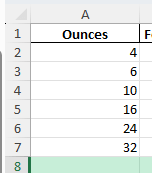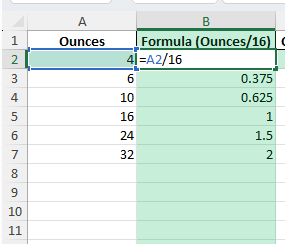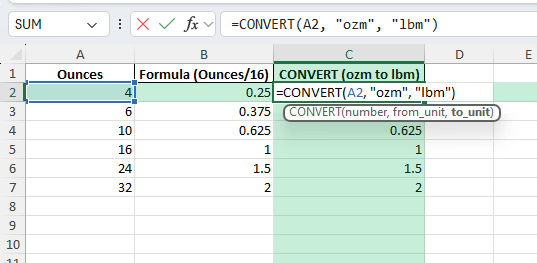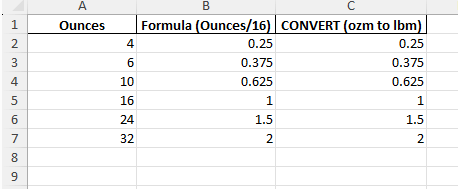Key Takeaways
- Excel’s CONVERT function can quickly convert ounces to pounds.
- Simple formulas can be used for custom conversions without special functions.
- Understanding unit abbreviations and conversion factors is essential.
- Helper columns and Power Query allow you to scale conversions to large data sets.
- VBA macros can automate repetitive conversion tasks across your sheets.
Table of Contents
About Ounce to Pound Conversion in Excel
An ounce (oz) and a pound (lb) are units of mass commonly used in the United States and many recipes. There are exactly 16 ounces in a pound. Converting between these units is a frequent need in inventory management, recipe calculations, food service, and science labs. Excel provides easy tools to perform this conversion, from built-in functions to custom formulas, even at scale.
1 lb = 16 oz, so dividing ounces by 16 gives pounds.
The CONVERT function in Excel covers dozens of unit pairs, including oz ↔ lbs.
Formulas and Power Query make mass conversion tasks quick and accurate.
Setting the Stage for Conversion
Understanding Measurement Units: Ounces and Pounds
Embarking on the journey of converting ounces to pounds begins with understanding these two fundamental units of weight. Ounces, often abbreviated as ‘oz’, are commonly used in the United States for smaller weights such as mail or food portions. One pound, which is abbreviated as ‘lb’, equates to 16 ounces and is a broader unit typically used for heavier or bulk items. Recognizing this relationship is essential since it forms the base of all conversion calculations: 1 lb = 16 oz.
Basics of the CONVERT Function in Excel
The CONVERT function in Excel is a versatile tool designed to transform data between different measurement units seamlessly. To convert ounces to pounds, this function becomes particularly handy. The basic syntax for the CONVERT function is =CONVERT(number, from_unit, to_unit). When converting 6 ounces to pounds, you would enter =CONVERT(6, "ozm", "lbm") into the Excel cell. Here, “ozm” stands for ounces, and “lbm” symbolizes pounds. This function ensures accuracy and efficiency, especially when dealing with larger datasets.
Step-by-Step: Convert 6 oz to lbs in Excel
Step 1: Set Up Your Data
Enter the ounces values in the first column.
Step 2: Use a Simple Formula
In cell B2, enter the formula:
=A2/16
This divides the ounces by 16 to convert to pounds. For 6 ounces, the result will be 0.375.
Step 3: Use the CONVERT Function
In cell C2, enter:
=CONVERT(A2, "ozm", "lbm")
“ozm” is the unit abbreviation for ounces (mass), and “lbm” is for pounds (mass).
This formula will also return 0.375 for 6 oz.
Common Mistakes and Tips
Mistake: Using the wrong unit abbreviation in CONVERT
Use “ozm” for ounce (mass) and “lbm” for pound (mass). “oz” alone may not work.
Mistake: Forgetting to divide by 16
There are 16 ounces in a pound. Multiplying instead of dividing gives the wrong answer.
Tip: Use helper columns to keep your raw data and calculated results separate for easier auditing.
Tip: Apply consistent number formatting for professional looking reports.
Tip: Store your unit conversion factor (16) in a named cell if you want to easily change it later.
Bonus Tips and Advanced Scenarios
Power Query Batch Conversion: Load your data to Power Query and add a custom column using [Ounces]/16 for batch conversions.
VBA Macro for Mass Conversion:
Sub ConvertOuncesToPounds()
Dim cell As Range
For Each cell In Range("A2:A100")
If IsNumeric(cell.Value) Then
cell.Offset(0, 1).Value = cell.Value / 16
End If
Next cell
End Sub
CONVERT for Other Units: You can use CONVERT to switch between other mass or volume units as needed (=CONVERT(A2,"g","ozm")).
Real-World Applications
Application in Personal Finance
In the realm of personal finance, precise weight conversions can play a subtle yet crucial role, particularly in budgeting for grocery purchases or price comparisons. When shopping, many products are priced by the pound or ounce; understanding these conversions can aid in making cost-effective decisions. For instance, if a particular food item is sold in different sizes, converting these weights into a consistent unit can help determine which offers the best value per pound.
Using Excel, track and compare these costs by creating a spreadsheet where you input the item’s size in ounces and apply the conversion formula to calculate the cost per pound. This approach allows for an at-a-glance comparison across various products, enabling you to optimize your spending. Over time, maintaining such a system can lead to substantial savings by ensuring you always choose the most economical options.
Inventory Management Use Cases
In inventory management, weight conversions are essential for streamlining stock tracking and order processing. Warehouses and retail businesses often deal with products in varying weight units, making consistency crucial for maintaining accurate inventory records and ensuring efficient logistics.
By using Excel, companies can convert product weights from ounces to pounds easily, allowing them to calculate total weights, optimize storage solutions, and manage shipping costs effectively. For instance, a spreadsheet could list all products with their weights in ounces. By applying the conversion formula, staff can quickly determine total inventory weight in pounds, aiding in decisions around shipping loads or storage capacity.
Additionally, automated weight conversion in inventory spreadsheets can help forecast restocking needs and manage reorder levels accurately, ensuring that inventory levels remain optimal without overstocking or stockouts. This level of precision supports superior inventory control, ultimately contributing to improved operational efficiency and cost management.
FAQ
Q: Can I convert from pounds back to ounces in Excel?
A: Yes, multiply pounds by 16, or use =CONVERT(A2, "lbm", "ozm").
Q: Does the CONVERT function work in all Excel versions?
A: CONVERT is available in most modern versions (Excel 2007 and newer). If not, use a simple formula.
Q: Can I use these conversions in charts and dashboards?
A: Yes, simply use the converted data as your source.
Q: Can I automate conversions for new data entries?
A: Yes, use formulas, fill down, Power Query, or VBA macros for automation.
Q: What if I need to convert between metric and US units?
A: CONVERT can handle grams, kilograms, ounces, pounds, and more.
John Michaloudis is a former accountant and finance analyst at General Electric, a Microsoft MVP since 2020, an Amazon #1 bestselling author of 4 Microsoft Excel books and teacher of Microsoft Excel & Office over at his flagship MyExcelOnline Academy Online Course.











